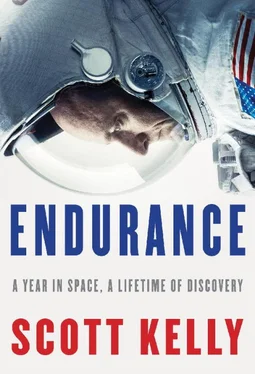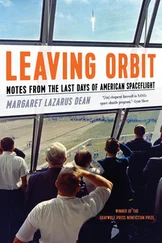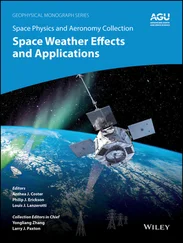In the Navy at that time, there was an idea that a single officer generally didn’t advance as quickly as a married one. This wasn’t a written rule—maybe it was even nonsense, but everyone believed it. Being a family man was supposedly an indicator of a certain kind of stability and maturity. I knew that all of the original Mercury astronauts Tom Wolfe wrote about were married, with at least two children. I wanted a family, and now that I was twenty-six and advancing in my career, it was starting to seem like the time was right. My brother was already married, and that added to the feeling that I should be ready for this stage of my life.
Leslie and I dated regularly for most of that year. I enjoyed going to her mother and stepfather’s for dinner every Sunday. (He had been a commander in the Navy Reserve.) I soon became close with Leslie’s brother and sister-in-law as well. It seemed like a logical next step to officially become part of their family. I asked Leslie to marry me over a bottle of wine sitting on a park bench on the edge of the Chesapeake Bay, and she said yes.
—
IN SEPTEMBER 1990, I was assigned to a real fighter squadron, VF=145, nicknamed The World Famous Pukin’ Dogs. They were based at the hangar right next door at Naval Air Station Oceana, so I didn’t have to move. The squadron was deployed in the Persian Gulf on the USS Eisenhower; since we were in the middle of Operation Desert Shield, I would join them when they returned.
Being in an F-14 squadron in the 1990s was like a cross between playing a professional sport and being in a rock-and-roll band. The movie Top Gun didn’t quite capture the arrogance and bravado of it all. The level of drunkenness and debauchery was unbelievable (and is, thankfully, no longer the standard). There were strippers in the Officers’ Club every Wednesday and Friday night, and it was a big party every time. On my first day, a senior officer in the squadron told me in no uncertain terms, “This squadron is about three things: flying, fighting, and fucking, and not necessarily in that order.” I told him I understood, and I did, at least about flying and fucking (sort of). But I was confused about the fighting part—I wasn’t sure whether he was referring to the Soviets or some other enemy combatant, or something else. In fact, it meant going to bars on the weekends with the intention of getting into bar fights. At the annual conference for naval aviators, known as Tailhook, the debauchery reached new levels. For example, some pilots decided to make their adjacent rooms into a suite by using a chainsaw to cut through the wall. Soon after, events at a Tailhook conference would create a sexual harassment scandal that made national news and resulted in a chain reaction of investigations, firings, and policy changes. Though I had never witnessed anything as extreme as the behavior that led to the scandal, I had witnessed behavior that crossed the line, and I always wondered how this could be acceptable in the military. I didn’t participate in it, but I hadn’t done anything to try to stop it, either. In the long term, the policy changes have been for the better. As a result of the shake-ups caused by the scandal, women were soon allowed to fly in combat for the first time. This created a much more even playing field and advanced the careers of a few talented women pilots, some of whom would later become my astronaut colleagues. Over the course of twenty years, many more would follow.
I continued to train over the course of the next year and flew to other air stations in Key West and Nevada to practice and continue acquiring new skills. I was with the squadron when it left for its next cruise on the USS Dwight D. Eisenhower (we called it Ike for short), in September 1991. We were headed to the Red Sea, the Persian Gulf, and the fjords of Norway. I would be gone for six months, during which I would fly the F-14 nearly every other day, on combat air patrol. The Soviet Union fell apart while we were at sea, and we didn’t know yet what that would mean.
One black night only a few weeks into the cruise, my RIO Ward Carroll (whom we called Mooch) and I launched in the Arabian Sea without a hitch and took up our combat air patrol position over the carrier. Our official duty was to protect our aircraft carrier’s battle group from airborne threats. In other words, we were there to shoot down any bombers or fighters that might be getting anywhere near us. We also used this time to do some training. When our hour-and-a-half sortie was over and it was time to head back, I heard Mooch say, “There’s land between us and the ship.”
“Land?”
I was pretty sure we hadn’t flown over any land. There wasn’t any bad weather forecast for that day, but the horizon had completely disappeared. Then I realized that the “land” we were seeing on our radar was sand—a haboob in Arabic, a giant sandstorm. It had completely engulfed the region, and it was likely going to make it a very tough night behind the boat.
As we got closer to the ship and leveled off to start our final approach, visibility was awful. I heard the air traffic controller say, “Salty Dog One Oh Three, three-quarters of a mile, call the ball.” He wanted me to confirm I could see the visual landing aids that would allow me to line up for landing. I looked outside and saw absolutely nothing. Then I heard the landing signal officer, who stands on the back of the ship to guide us in, say, “Paddles contact, keep it coming,” meaning he could see us even if we couldn’t see him. We continued our descent toward the ship.
When we were less than a quarter mile away, I could finally see the carrier. At 150 miles per hour, I had about five seconds to make corrections to line up the airplane with the centerline and adjust our altitude and speed to land in the right spot on the flight deck, right before the third arresting cable. We touched down. As usual, I went to full power, always necessary in case the landing wasn’t successful and I would have to take off again instantly. I expected to feel the comforting pull of the arresting wire bringing us to a stop—but it never came.
“Bolter, bolter, bolter…hook skip,” called the landing signal officer, the LSO. To bolter means to fail to catch the arresting wire with the airplane’s tailhook. We had to immediately accelerate at full throttle in order to take off again and circle around for another attempt. Off we went back into the sandy darkness of the sky. I was frustrated because I hadn’t done anything wrong—I was just unlucky. The hook had skipped over the wires. We came in again, only to experience another bolter. We came around again. Another bolter. We came around again. Now we got a wave-off, meaning our approach was so ugly they wouldn’t let me try to land for fear I’d crash. Now I was seriously getting angry with myself and nervous.
The visibility was not improving, and we were running out of gas. We went around a number of times more, which only resulted in more bolters—wave-offs because we were too close to the airplane in front of us and wave-offs for performance (in other words, shitty flying on my part). Eventually we were “trick or treat,” which means we either had to land this time or go get more gas. I boltered again. We were off to the tanker.
The tanker was an A-6 Intruder configured with external fuel tanks that circles overhead at three thousand feet, ready to refuel airplanes. Finding the tanker was a challenge in itself, because we were still engulfed in the sandstorm. We did a radar-only rendezvous, which was very risky, with Mooch calling out range, bearing, and closure as we approached. Once I was within twenty-five feet or so, I was able to see the tanker and join up on its wing. I extended my refueling probe, but the bumpiness of the air and the fact that I had gone around so many times in attempts to land on the ship had me thoroughly unsettled. It took me multiple attempts to make contact, during which I tried not to think about what would happen if we couldn’t refuel: we would have to eject or take our chances with the barricade (a net rigged on the deck to catch the airplane), both very dangerous. Once I finally did make contact with the tanker and refueled, I headed back toward the ship.
Читать дальше












